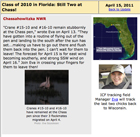The first whoopers have crossed into Canada and only 10 remain in Texas. Two youngsters stubbornly remain in Florida while most of their Eastern flockmates are back in Wisconsin, where nesting has begun! Calculate for #6-10's journey north. Celebrate freedom for the Louisiana cranes with this week's video clip and salute Tom Stehn's help for cranes.
Today's Report Includes:
- News: Migration Map and Field Reports
- Migration Math: #6-10's Travels
- Nesting Begins: Suspense in Wisconsin
- Tribute: Tom Stehn's Cranes
- Video: First Flights to Freedom
- Research Question and Quick Links: Helpful Resources to Explore

Image:
Sue Kersey
This is a
"famous" male from the Western flock. Study the image. What
can you tell and what can you learn?
 |
|
|
|
Data /Map/Finish
Line |
Latest
News: Western Flock The first cranes have crossed into Canada! With only 10 cranes remaining and an estimated 269 in migration, 96.4% of the flock has left the Texas winter home. Why do they go so far to nest? More |
Latest
News: Eastern flock |
Female #6-10 began migration from St. Marks NW in Florida on April 3. She completed migration to Necedah NWR this week, on April 12. She traveled about 1791 km. Visit her bio page to find out how many stops she made. Then answer in your journal:
- How many miles did she fly?
- How many stopovers did she make?
- In how many states did she stop?
- How many days did her migration take?
- What was her average distance per day?
Whoopee! Seven pairs (maybe eight) in the Eastern flock are already sitting on nests!
| #505 and #415 | #317 and #303 |
| #401 and #508 | #216 and #716 |
| #307 and #726 | #310 and W1-06 |
| #403 and #309 |
How many
of these nesting pairs have nested before? What were the results? See:
Nesting
Summary, Eastern Flock
Every egg is precious! Video cameras monitor the progress so the parents won't be disturbed. We hope that the parents can incubate for the necessary 30 days without being driven off by pesky black flies, which has been a big problem at Necedah NWR.
Imagine watching over a flock
of endangered whooping cranes on their wintering grounds every year since
1982! You
would have felt many worries and many celebrations. That's been biologist
Tom Stehn's career. This week Tom told us, "This
will be the last flight of the spring unless one additional flight is
made in May to see if the 10 have departed. My thanks go to
Brad Strobel who has capably taken over the census flights as I wind
down towards retirement sometime later this year."
We salute Tom Stehn with heartfelt affection and respect. Here's why:

Tom carries a sick crane in the bad winter of 2008. More
"I've had the honor of being the first person to count in 1986 more than 100 whooping cranes at Aransas, and more than 200 in 2004. I'm certainly hoping that next winter will stand out at Aransas with a good chance for the first time of more than 300 whooping cranes ever returning to Aransas NWR, above its current estimated size of 279. That would be a real cause of celebration for a species that 70 years ago numbered only 15 birds in existence in Texas. Wow, what a sensational comeback story for a very majestic and very proud bird! They can do it, if humans will just leave them alone and give them a chance!"
Research Question: When and how did people find out about the nesting grounds of the Western flock?
See: How the Western Flock's Nesting Grounds were Discovered
- Lesson: The Natural Flock's Nesting Grounds in Canada
- Crane Conservation: New Louisiana Flock
- Slideshow: Meet Al and Diane, the Flock's Most Productive Cranes
- Record Keeping: Arrival Log for Eastern Flock
- Booklets, Slideshows, Photo Studies: Journey North for Kids

Image:
Billie Dodd
What's the latest news about female #519 and her boyfriends?
Making Good Sightings: Official WCEP Reporting form
The Next Whooping Crane Migration Update Will Be Posted on April 22, 2011.






